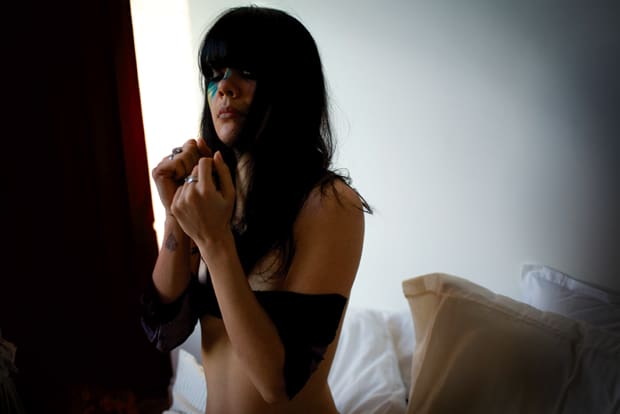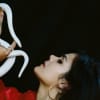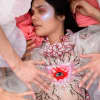In her supple, lullaby-like speaking voice, Natasha Khan slowly reels me in. She’s describing the story of “Glass,” the ambitious opener to Two Suns, her second album as Bat For Lashes. In the song, amidst hand drums, crashing cymbals, field recordings from a Brooklyn subway stop on the JMZ line and the sound your finger makes when you rub the rim of a half-filled glass, Khan’s vocals charge like an unbridled unicorn. She invites the listener to float into the middle distance and picture a castle made of crystal where watchmen in the towers point to a glass knight whose heart burns bright as the sun.
“Every time I get close, his heart vibrates, gets stronger and we get blinded by it,” Khan says. “So I try and make him a cloak made of rainbow colors to refract the light so we can be close, but every time we do, the suns in our chests set fire to everything. In the end, the two suns burning so hotly creates a third thing, a perfect white diamond that flings into space and we become two planets constantly orbiting, basking in each others light, always separated, but there is that diamond that remains.” This cosmic talk is all metaphor of course, cloaking the timeless themes that dominate Two Suns, as well as Khan’s experience making it: journey, love, struggle and resolution.
In music and in person, Khan has the ability to take what is personal and vault it into the surreal without losing any of its emotional impact. There is a confidence and calmness that allows her to speak of her strange visions as if they were common thoughts. She taps into a wistful desire to spend hours up in a tree scribbling stories in a spiral notebook and conjures memories of riding through pine forests on a lavender bike pretending it is a pony. But this realm Khan creates isn’t childlike, rather it’s fantastically transportive. She is able to access that sliver of self that remains crouching beneath a fort made of sheets and chairs where a friend whispers wonders in your ear.
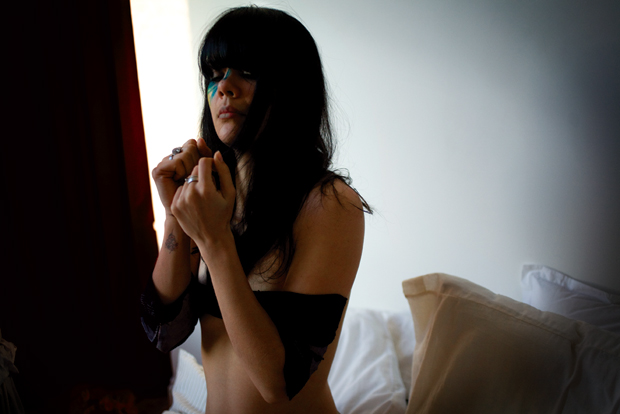
In 2006, Bat For Lashes captivated listeners with her debut Fur and Gold, a baroque collection steeped in elegiac strings and eerie auto-harp that turned her into a sensation in her native England. Khan’s dramatic vocals garnered comparisons to beloved weird women Björk and Kate Bush. Her lyrics were populated with imagery unspooled from the verdant fabric of her imagination: mystical horses, a suicide pact couple dead in a car and animalistic sexuality personified as The Wizard. Fur and Gold is currently being transformed into a musical project for the theater, turning her songs into a narrative aimed to capture the minds of kids. It’s a fitting move for a woman who was once a nursery school teacher.
Khan’s popularity has been slow burning but intense. Her live shows are sold out and reverential, with her often encouraging audiences to howl like wild wolves. She’s received two Brit Award nods and a nomination for the prestigious Mercury Prize from UK critics. Björk called her “amazing” and Kanye West posted her Donnie Darko-inspired video for “What’s A Girl To Do?” on his blog, enthusing, “I USED TO WANT TO BE A FREESTYLE BIKER, SO I EXTRA LOVE THIS VIDEO.” Then Radiohead requested that Bat For Lashes open their European tour. Of that experience, Khan says her relationship with Thom Yorke was awkwardly jokey, an uncomfortability you’d expect from one artist whose music is defined by free-spiritedness and another whose is defined by anxiety. “Only on the final night we did have a really good talk,” she says. “He reassured me to do the second album how I wanted, to protect my vision.”
The film obsessed, former music and visual arts student chose to meet at the Duke of York Picturehouse in her adopted hometown of Brighton. Originally opened in 1910, the one-screen theater maintains an elegant Edwardian visage, except for a pair of giant, black and white striped legs plonked on the roof, frozen in a disembodied can-can. “I remember seeing so many films that were influential to me here: The Virgin Suicides, Buffalo 66, Dancer in the Dark and Donnie Darko—all in the space of a year,” she says over her shoulder as we walk up the narrow staircase to the deserted, sun-flooded cinema café. Wearing pale blue jeans, a white lace hoodie and mismatched earrings, Khan looks much younger than her twenty-nine years. There’s a pinprick beauty spot just right of center of her button nose and she tends to push her inky black hair over her face when telling an embarrassing story. Today she’s stripped of the glitter that normally flecks her cheeks onstage, but there’s a trace of gold on her eyelids and turquoise beneath her lower lashes.

Khan is feeling more settled than she has in years, recently buying an airy apartment in Brighton with twenty-foot ceilings and a view of the sparkling sea. Twelve months ago she left this seaside city to move to Williamsburg, Brooklyn to be with her then-boyfriend, Will Lemon, an artist and the lead-singer of Moon and Moon. The pair were introduced several years prior by Devendra Banhart, an early supporter of Khan’s music who she calls a kindred spirit.
Although the UK is currently a-buzz with new, innovative female acts like Little Boots, Micachu and Florence & The Machine, Khan has always existed in her own separate world. Once in Brooklyn she found herself at home amongst Gang Gang Dance, TV On The Radio and MGMT. With Lemon as her portal, she was embraced by a musical community that she doesn’t have in the UK. Khan is not a scene-seeker, and living in Brighton keeps her away from London’s musical enclaves that are largely defined by genre and ZIP code.
It was in New York that Pearl, an illusory blonde femme fatale first emerged. Khan would wear a platinum wig “stalking the nighttime streets” while her friend Jordan took pictures. She’d appear at parties as this new character with massive eyelashes, blue eye shadow and red lips. “It was really interesting psychologically,” she says of her transformation from a brunette. “People seemed slightly intimidated, and there’s a lot more sexual tension in the air.”
Pearl was the seductress who arose when Khan found that for all its inspiring inhabitants, her gilded vision of New York, her Emerald City, didn’t quite match reality. “I moved out there to try and start a different life, but I think I was in love with an old, early ’80s New York when things were a bit wilder,” she says. “I also found it quite hard to be in the city constantly. It’s so grey and oppressive. I’ve lived by the sea for so long, and having that horizon, that natural force nearby, was keeping me going without me even realizing it.”
The Natasha Khan vs. Pearl dynamic isn’t about performance or persona, like Beyoncé’s Sasha Fierce or David Bowie’s Ziggy Stardust. Rather it’s an inner split: Pearl is the escapist, drama-prone, devastating id, to Khan’s rational superego. She’s a “subterranean prowling witch,” at odds with Khan’s “desert being, which is very much about nature, inter-connectiveness and acceptance." The specters of these opposing forces are present throughout Two Suns. Khan says “Travelling Woman,” a dusky piano ballad, “is very much from my aware side,” a gentle note-to-self to hold onto her convictions. The purely Khan songs provide Two Suns’ most traditional, yet tender moments, but it’s “Two Planets” and “Pearl’s Dream” that mark the biggest departures from previous Bat For Lashes material. The latter features menacing programmed beats, skittering handclaps and terminator bass courtesy of Chris Keating and Ira Wolf Tuton of Brooklyn’s global pop experimentalists Yeasayer. The pair also contributed to Two Suns' first single, “Daniel,” an exhilarating pop number that is sure to whirl the world’s new age warriors.
Sometimes the two halves duel directly, as on “Siren’s Song,” where the languid verses find Khan contemplating what it is to be a perfect, nurturing woman (keeping the bed warm and being “proud when you dazzle”), but in the chorus Pearl comes crashing in, destroying the calm with cacophonous piano chords and insistent drums. But a conclusion is found with “The Big Sleep,” the album’s closer that features cult ’60s crooner Scott Walker, an internet collaboration that Khan still can’t quite believe happened. The song is Pearl’s finale. “The curtain's coming down, she’s going to take her millions of sleeping pills and finally enter nothingness,” says Khan. “She had to subside. The aware side of me woke up, and the more I woke up, the more Pearl fell asleep.”
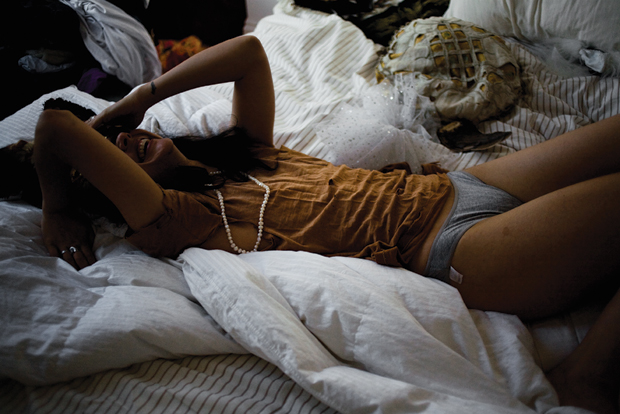
The seeds of inspiration for Pearl were largely visual: the portraits of Cindy Sherman, the shape-shifting drag queens of Paris is Burning and particularly the 1955 film noir The Night of the Hunter, where a young boy and his even smaller sister Pearl try to escape Robert Mitchum’s murderous preacher. “Perhaps my Pearl is like that little Pearl grown up, orphaned and traveling down this dreamy river surrounded by dark forces,” says Khan. “Also, in folklore the pearl is like a droplet of the moon falling into the ocean. She’s supposed to govern the subconscious world.”
There is another presence within Two Suns who is every bit as vital as Khan and Pearl. He is the knight in “Glass,” the bear in “Moon and Moon,” the romantic other of “Daniel,” the lover between Khan’s warring halves in “Siren’s Song” and he also stands in the scorched battlefield of “Pearl’s Dream.” Khan won’t go into the details of her personal life, but it’s clear she’s taken the dissolution of a relationship she calls “absolutely the most inspiring and beautiful thing I’ve ever experienced” and preserved it as a fable. “Personally and geographically it wasn’t right, but it was also very right in terms of inspiration,” she says.
The next afternoon we meet at the EMI offices in West London where Khan is editing footage to accompany Two Suns, shot during a mind-clearing trip to Joshua Tree, California. “I’m so excited to be making films again, it’s been ages!” she says before instructing the editor to crossfade a frame of a twilight highway into a shot of her gazing out a car window as the desert flies by. She laughs at a slow motion segment of her silhouetted in a gauzy kaftan, holding up two glinting silvery globes. “I’m so cosmic and happy!” she says.
Even more so than Fur and Gold, Two Suns is a self-contained galaxy that Khan has meticulously conceptualized. The cover is a shot of Khan as herself, surrounded by a shrine of candles and “timeless symbols like boulders and trees.” On the flipside is a portrait of Khan as Pearl, crowned with a neon halo. In both she is draped in a lace hoodie (white for Khan and black for Pearl), specially created for her by Alexander McQueen’s diffusion label McQ.
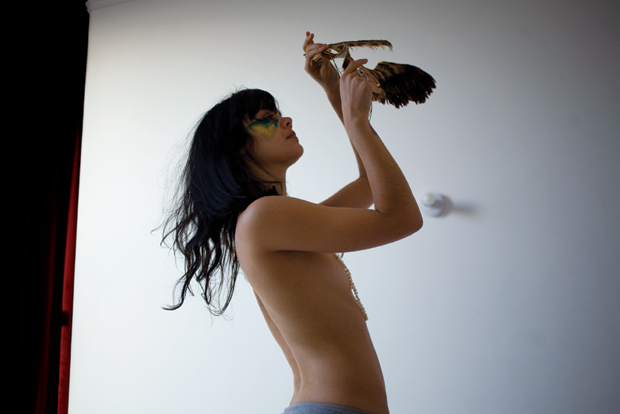
Khan is moving away from her previous staples of animal totems and the sparkling headbands that have become a ubiquitous fashion accessory. Right now she’s really into “lots of spray painted, Jean-Michel Basquiat-type vibes, clothes that are quite ’80s and street looking.” She’s also fascinated by skin printing—a process of painting and stenciling patterns and pictures onto the body—which she credits to her ex-boyfriend. Khan is not only spray-painted for Two Sun’s front cover, she spent a December day having the face of Daniel Larusso, the Karate Kid protagonist and her childhood crush, painted on her naked back for the “Daniel” single’s artwork“.
Khan is not religious, but Two Suns does begin with her singing from the Song of Solomon, excerpts of which she read in Hubert Selby’s Jr.’s Last Exit to Brooklyn. When Khan was little, she would travel with her father to Pakistan to visit his side of the family. Rehmat Khan is the famed squash coach who trained his cousin, Jahangir Khan, to become a world champion player. Khan describes her father as “very charming and artistic, a little bit unreliable, immature and selfish.” He is also a devout Muslim who encouraged the traditional five daily prayers. “I think for a long time [religion] was quite an enigma,” says Khan. “I took the ritualistic side—the washing before you pray, the repetition of words—but paradoxically, I didn’t know what any of it meant.”
When Khan’s father left her family when she was eleven, “everything flip-reversed” and she found herself at Christian school singing hymns in the morning, even though religious practice wasn’t something Khan’s English mother enforced. “Later I decided to find something more concrete that I could understand experientially,” she says. “But what religion helped me with was storytelling. I’m interested in creating your own mythology and using imagery to deal with human emotion.”
One of the stories that Khan tells that hasn’t bled into her lyrics yet is a moment on a beach in Malibu last year. “I was walking along the shore, crying because I was having a really bad day, singing to myself and feeling emotional,” she recalls. “The sun was setting and a school of nine dolphins came swimming by. My girlfriends were like, Tasha! Oh my god! It’s your spirit animal! I needed to reach out to some kind of objectivity, some universal cosmic something. You can just drown in the vortex, but when they came, it snapped me out. To see the beauty of being, they’re so free and wild.” Khan says that this actually happened twice, although the second time, her presence only brought three dolphins to the shore.
